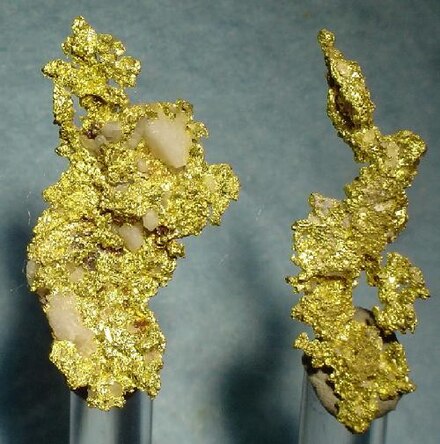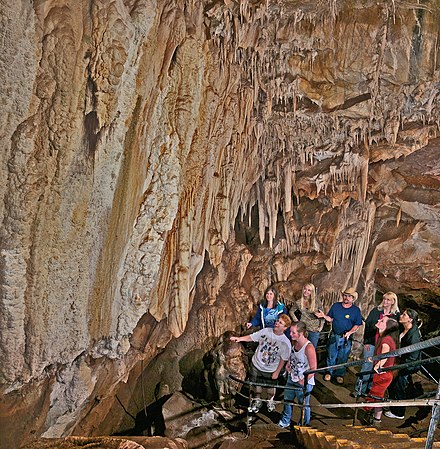Gold Country - Historic gold-mining region in Northern California

Gold Country is a region of California that includes foothills of the western Sierra Nevada mountains and many historic towns that date to the 1849 California Gold Rush. Today highway 49 winds its way through small towns that protect the legacy of California's early settlers.
Counties
Amador County was home to several mines during the Gold Rush, including the Kennedy Mine in Jackson which was the deepest gold mine of its time. Today the county is known for its Zinfandel, with the Shenandoah Valley home to over forty wineries. Visitors may also enjoy Black Chasm Cavern in Volcano, historic buildings, and outdoor activities such as skiing, camping and fishing.
Sparsely populated Calaveras County inspired author Mark Twain's first successful story "The Celebrated Jumping Frog of Calaveras County", and today visitors can both visit Twain's cabin and enjoy the annual Jumping Frog Jubilee in the tiny town of Angels Camp. The county is also home to several natural caves, a handful of wineries, Gold Rush history, and giant sequoia trees in Calaveras Big Trees State Park.
"El Dorado" is Spanish for "the gilded/golden", an appropriate name for the county where the California Gold Rush was kicked off after a discovery at Sutter's Mill (near Coloma) in 1848. The county's attractions include mountain scenery, gold mining history, the impossibly blue waters of Lake Tahoe, backpacking opportunities in the Desolation Wilderness, and epic skiing in the South Lake Tahoe area.
Madera County's agricultural western half offers plenty of hotels and amenities for travelers, while the mountainous eastern half features unspoiled Sierra Nevada wilderness that is home to portions of Yosemite National Park, the Ansel Adams Wilderness, and Devils Postpile National Monument with its impressive basalt columns and iconic Rainbow Falls. Be aware that there are no roads crossing the county from west to east, so it may be a very circuitous route for those who want to see everything Madera has to offer!
Mariposa was the largest county in California at the time of statehood in 1850, but later ceded land that formed twelve other counties. Today it maintains a relatively small footprint in the Sierra Nevada foothills, but has kept one of the state's treasures: Yosemite National Park, home to impossibly tall granite cliffs, remote alpine wilderness, and an iconic valley.
Rising from the Sierra foothills to the Nevada border, this county retains many examples of its Gold Rush past, ranging from California's oldest operating theater in Nevada City to the Holbrooke Hotel in Grass Valley, an establishment that has hosted four Presidents since its opening in 1851. Even before the Gold Rush, the county gained fame for the ill-fated Donner Party of 1846, and today the lake named for that doomed expedition is a popular recreation spot.
Placer County stretches from the suburbs of Sacramento to Lake Tahoe and the Nevada border. Named after the Spanish word meaning "sand or gravel deposits containing gold", the county was a hotbed of activity during the Gold Rush. Today visitors can enjoy mountain activities such as hiking and skiing, and will also be impressed by the historic courthouse in Auburn.
Located in the mountains and forests adjacent to the Nevada border, Sierra County was a booming mining area during the Gold Rush, but today is home to only about 3,000 people. Historically the county was the site of several massive gold discoveries, including the 106 pound Monumental Nugget in 1869; a replica of the huge nugget can be seen in the Kentucky Mine Museum in Sierra City.
Tuolumne County was one of California's original counties at the time of statehood, and today offers a glimpse into the region's gold mining and logging history, as well as numerous opportunities for outdoor recreation. Portions of Yosemite National Park lie in the county, and with limited parking and lodging inside of the park, the YARTS shuttle system makes the county's towns an option to consider for park visitors.
{{mapshape|type=geoshape|fill=|title=Amador County|wikidata=Q156177}} {{mapshape|type=geoshape|fill=|title=Calaveras County|wikidata=Q271613}} {{mapshape|type=geoshape|fill=|title=El Dorado County|wikidata=Q108093}} {{mapshape|type=geoshape|fill=|title=Madera County|wikidata=Q109661}} {{mapshape|type=geoshape|fill=|title=Mariposa County|wikidata=Q156191}} {{mapshape|type=geoshape|fill=|title=Nevada County|wikidata=Q109681}} {{mapshape|type=geoshape|fill=|title=Placer County|wikidata=Q156353}} {{mapshape|type=geoshape|fill=|title=Sierra County|wikidata=Q156370}} {{mapshape|type=geoshape|fill=|title=Tuolumne County|wikidata=Q156346}}
Cities
- Auburn - Auburn was established as a mining camp in 1849, and its rapid growth led to it becoming the county seat of Placer County just two years later in 1851. Today travelers can visit the historic downtown, including the Placer County Courthouse which now houses a museum. Outside of town, the Hidden Falls Regional Park boasts over of multi-use trails, and the Auburn State Recreation Area provides boating and hiking along of the North and Middle Forks of the American river. Other area trails host a variety of extreme endurance challenges each year, including the Western States Endurance Run.
- Coloma - The California Gold Rush began in Coloma in 1848 with the discovery of gold at Sutter's Mill, and today travelers can visit the Marshall Gold Discovery State Historic Park to see the exact spot where gold was found. In addition, the park has a recreation of Sutter's Mill, exhibits documenting the Gold Rush, and the opportunity to pan for gold in the American River. While much of the original town is now essentially a ghost town, there are a few lodging options and restaurants. For visitors seeking adventure, the American River is a popular whitewater rafting destination, and a number of outfitters offer trips that start in Coloma.
- Grass Valley
- Jamestown
- Mariposa
- Murphys - The small town of Murphys is a Gold Rush era town that today features over a dozen wine tasting rooms and a surprising number of excellent restaurants on its historic Main Street. The town also hosts an annual Irish festival in March that draws thousands of visitors. There are several wineries nearby, and visitors may also want to make the one mile journey north of Murphys to take a paid tour through Mercer Caverns, a short cave filled with a large number of speleothems, stalactites, and stalagmites.
- Placerville - Placerville is a town that played a key role in the Gold Rush, with a historic downtown that hearkens back to when it was originally incorporated as California's third largest town in 1857. Travelers looking for a place to stop on the way from Sacramento to Lake Tahoe can visit the downtown and shop in the oldest continually operated hardware store west of the Mississippi, or learn about the area's history in a museum housed in a former soda works. In addition, the town hosts the El Dorado County Fair each Father's Day weekend, an event which has been held since 1859 and attracts about 65,000 visitors over its four day run.
- Roseville
- Sonora
Other destinations
Understand

The California Gold Rush began in 1848 at Sutter's Mill (near Coloma) where the first gold nugget was discovered, touching off a massive influx of people seeking their fortune. This was arguably the largest migration of the human race in such a short time. While most of these prospectors failed in their efforts to gain riches (the ones who made the money were the shopkeepers), their legacy remains in the many towns that now cluster amongst the foothills of the Sierra Nevada mountains.
Get in
Get around
Go next
- The Sierra Nevada and Western Nevada to the east
- The Sacramento Valley and San Joaquin Valley to the west
- Shasta Cascades to the north
Gold Country
Timezone:MultipleCoordinates:38.40, -120.80